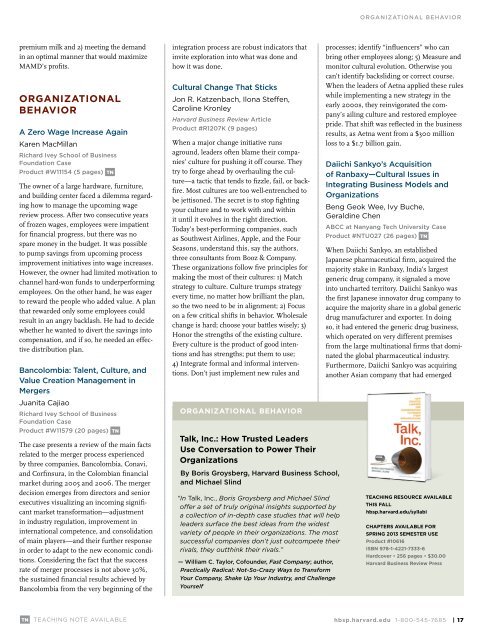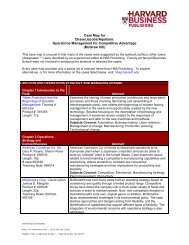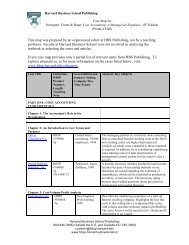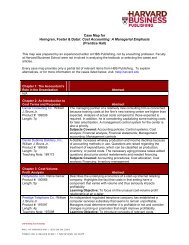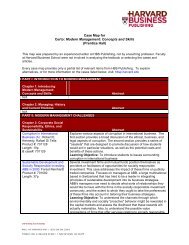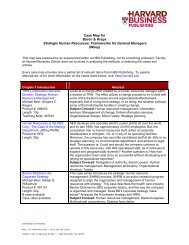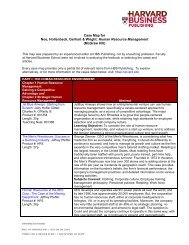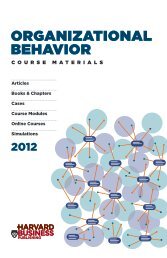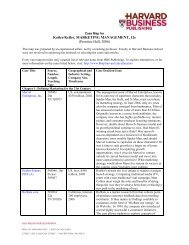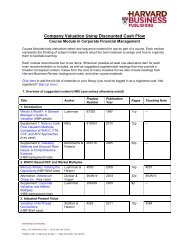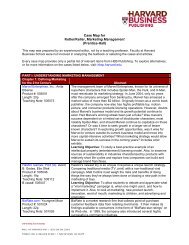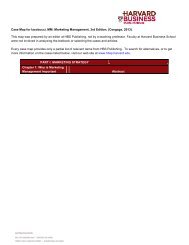teAcHing MATErIAlS - Harvard Business School Press
teAcHing MATErIAlS - Harvard Business School Press
teAcHing MATErIAlS - Harvard Business School Press
You also want an ePaper? Increase the reach of your titles
YUMPU automatically turns print PDFs into web optimized ePapers that Google loves.
premium milk and 2) meeting the demand<br />
in an optimal manner that would maximize<br />
MAMD’s profits.<br />
orgAniZAtionAl<br />
BeHAvior<br />
A Zero Wage Increase Again<br />
Karen MacMillan<br />
Richard Ivey <strong>School</strong> of <strong>Business</strong><br />
Foundation Case<br />
Product #W11154 (5 pages) tn<br />
The owner of a large hardware, furniture,<br />
and building center faced a dilemma regarding<br />
how to manage the upcoming wage<br />
review process. After two consecutive years<br />
of frozen wages, employees were impatient<br />
for financial progress, but there was no<br />
spare money in the budget. It was possible<br />
to pump savings from upcoming process<br />
improvement initiatives into wage increases.<br />
However, the owner had limited motivation to<br />
channel hard-won funds to underperforming<br />
employees. On the other hand, he was eager<br />
to reward the people who added value. A plan<br />
that rewarded only some employees could<br />
result in an angry backlash. He had to decide<br />
whether he wanted to divert the savings into<br />
compensation, and if so, he needed an effective<br />
distribution plan.<br />
Bancolombia: Talent, Culture, and<br />
Value Creation Management in<br />
Mergers<br />
Juanita Cajiao<br />
Richard Ivey <strong>School</strong> of <strong>Business</strong><br />
Foundation Case<br />
Product #W11579 (20 pages) tn<br />
The case presents a review of the main facts<br />
related to the merger process experienced<br />
by three companies, Bancolombia, Conavi,<br />
and Corfinsura, in the Colombian financial<br />
market during 2005 and 2006. The merger<br />
decision emerges from directors and senior<br />
executives visualizing an incoming significant<br />
market transformation—adjustment<br />
in industry regulation, improvement in<br />
international competence, and consolidation<br />
of main players—and their further response<br />
in order to adapt to the new economic conditions.<br />
Considering the fact that the success<br />
rate of merger processes is not above 30%,<br />
the sustained financial results achieved by<br />
Bancolombia from the very beginning of the<br />
tn TEAChiNG NOTE AVAiLABLE<br />
integration process are robust indicators that<br />
invite exploration into what was done and<br />
how it was done.<br />
Cultural Change That Sticks<br />
Jon R. Katzenbach, ilona Steffen,<br />
Caroline Kronley<br />
<strong>Harvard</strong> <strong>Business</strong> Review Article<br />
Product #R1207K (9 pages)<br />
When a major change initiative runs<br />
aground, leaders often blame their companies’<br />
culture for pushing it off course. They<br />
try to forge ahead by overhauling the culture—a<br />
tactic that tends to fizzle, fail, or backfire.<br />
Most cultures are too well-entrenched to<br />
be jettisoned. The secret is to stop fighting<br />
your culture and to work with and within<br />
it until it evolves in the right direction.<br />
Today’s best-performing companies, such<br />
as Southwest Airlines, Apple, and the Four<br />
Seasons, understand this, say the authors,<br />
three consultants from Booz & Company.<br />
These organizations follow five principles for<br />
making the most of their cultures: 1) Match<br />
strategy to culture. Culture trumps strategy<br />
every time, no matter how brilliant the plan,<br />
so the two need to be in alignment; 2) Focus<br />
on a few critical shifts in behavior. Wholesale<br />
change is hard; choose your battles wisely; 3)<br />
Honor the strengths of the existing culture.<br />
Every culture is the product of good intentions<br />
and has strengths; put them to use;<br />
4) Integrate formal and informal interventions.<br />
Don’t just implement new rules and<br />
orgAniZAtionAl BeHAvior<br />
talk, inc.: How trusted leaders<br />
use conversation to power their<br />
organizations<br />
By Boris Groysberg, <strong>Harvard</strong> <strong>Business</strong> <strong>School</strong>,<br />
and Michael Slind<br />
“In Talk, inc., Boris Groysberg and Michael Slind<br />
offer a set of truly original insights supported by<br />
a collection of in-depth case studies that will help<br />
leaders surface the best ideas from the widest<br />
variety of people in their organizations. The most<br />
successful companies don’t just outcompete their<br />
rivals, they outthink their rivals.”<br />
— William C. Taylor, Cofounder, Fast Company; author,<br />
Practically Radical: Not-So-Crazy Ways to Transform<br />
Your Company, Shake Up Your Industry, and Challenge<br />
Yourself<br />
ORGANIZATIONAL BEHAVIOR<br />
processes; identify “influencers” who can<br />
bring other employees along; 5) Measure and<br />
monitor cultural evolution. Otherwise you<br />
can’t identify backsliding or correct course.<br />
When the leaders of Aetna applied these rules<br />
while implementing a new strategy in the<br />
early 2000s, they reinvigorated the company’s<br />
ailing culture and restored employee<br />
pride. That shift was reflected in the business<br />
results, as Aetna went from a $300 million<br />
loss to a $1.7 billion gain.<br />
Daiichi Sankyo’s Acquisition<br />
of Ranbaxy—Cultural Issues in<br />
Integrating <strong>Business</strong> Models and<br />
Organizations<br />
Beng Geok Wee, ivy Buche,<br />
Geraldine Chen<br />
ABCC at Nanyang Tech University Case<br />
Product #NTU027 (26 pages) tn<br />
When Daiichi Sankyo, an established<br />
Japanese pharmaceutical firm, acquired the<br />
majority stake in Ranbaxy, India’s largest<br />
generic drug company, it signaled a move<br />
into uncharted territory. Daiichi Sankyo was<br />
the first Japanese innovator drug company to<br />
acquire the majority share in a global generic<br />
drug manufacturer and exporter. In doing<br />
so, it had entered the generic drug business,<br />
which operated on very different premises<br />
from the large multinational firms that dominated<br />
the global pharmaceutical industry.<br />
Furthermore, Daiichi Sankyo was acquiring<br />
another Asian company that had emerged<br />
<strong>teAcHing</strong> resource AvAilABle<br />
tHis fAll<br />
hbsp.harvard.edu/syllabi<br />
cHApters AvAilABle for<br />
spring 2013 semester use<br />
product #10616<br />
isBn 978-1-4221-7333-6<br />
Hardcover • 256 pages • $30.00<br />
<strong>Harvard</strong> <strong>Business</strong> review press<br />
hbsp.harvard.edu 1-800-545-7685 | 17


